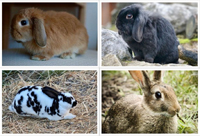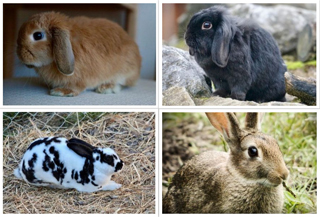Flat faces, floppy ears linked to poor health; average pets in UK found to die young

bunny collage 320

Top left: With a very flat face and lop ears, this rabbit is an extreme example of unhealthy traits that many pet owners find cute. Wikimedia Commons photo.
Top right: This rabbit is considered to have a moderately brachycephalic (broad and wide) skull. Pixabay photo.
Bottom left: Rabbit welfare advocates recommend a face shape and ear position like this rabbit's, which is similar to that of rabbits in the wild. Pixabay photo.
Bottom right: This wild-type rabbit has a relatively long face and erect ears. Flickr photo by Martyn Fletcher.
Click here for a larger view
Teeth grow up through jaws, puncturing eye sockets. Maggots form in body cavities, killing their host. A fungus-like invader infects blood, damaging the central nervous system.
These are not freak or unfortunate occurrences suffered by rabbits only in the wild. They are conditions faced by pet rabbits that three new studies published in the United Kingdom suggest are occurring on a large scale.
One of the papers indicates, for the first time, a predilection among the general public for brachycephalic (flat-faced) breeds, which are more prone to excruciating dental conditions.
Another study finds that rabbits with floppy ears are more at risk of serious illness, including deafness and dental problems.
And a third paper finds that pet rabbits in the U.K. die at a median age of 4.3 years, even though domesticated rabbits can live to 10 years and older. Dental problems causing starvation were commonly documented in that third piece of research; poor care of rabbits by their owners also was cited as a leading cause of premature death.
"We've still got major problems with rabbit welfare and rabbit health — and almost all of them are preventable," said Naomi Harvey, a research fellow with expertise in animal behavior and welfare at the University of Nottingham School of Veterinary Medicine and Science.
Harvey led the study "What Makes a Rabbit Cute? Preference for Rabbit Faces Differs according to Skull Morphology and Demographic Factors," published Sept. 26 in the journal Animals. Harvey and collaborators conducted the research during their free time, without compensation, presenting it as a fun activity on social media. And apparently it was received with delight, attracting 20,858 responses from around the globe.
"It was incredible — we couldn't believe the response that we received," Harvey told the VIN News Service. "It snowballed, essentially."
Respondents were shown photographs of 25 rabbit faces that were assigned to a face-type group by 134 veterinary professionals. Participants rated each of the images on a scale of 0 to 10, with 0 being "I do not like this rabbit at all" and 10 being "This is my favorite type of rabbit."
Among the results: The rabbits least likely to receive a score of 9 or 10 had long faces more typical of wild animals. Scoring the most 9s and 10s were images of mildly brachycephalic rabbits, which were 3.31 times more likely to receive high scores compared with long-faced breeds.
Those that were moderately or extremely brachycephalic were 2.84 and 1.97 times more likely, respectively, to receive a high score.
Dr. Richard Saunders, a zoo and wild animal specialist with 25 years of experience as a practitioner, said that dental disease is one of the most common clinical presentations for rabbits. Brachycephalic breeds, he said, are far more likely to experience problems due to a lack of space in their mouths and misaligned jaws.
Saunders recalled occasions in which he has seen overgrown teeth pressuring the patient's eye sockets, blocking its tear ducts and causing a discharge to the face.
"The conditions can be horrific, and they can suffer really, really badly," he told VIN News. "They're presented to vets usually because they're losing weight because they can't eat properly."
In severe cases, Saunders said, the best course of action usually is to euthanize the animal to end its pain. In less severe cases, the patient can be treated by shortening or removing teeth, but lifelong management is required.
"Face length is a causal factor in these rabbits doing really badly in life," said Saunders, staff veterinarian at the Bristol Zoological Society and veterinary adviser to the Rabbit Welfare Association and Fund.
Ear posture can cause problems, too, according to research by academics at Britain's Royal Veterinary College. In a study titled "Lop-eared rabbits have more aural and dental problems than erect-eared rabbits: a rescue population study," a not-yet-peer-reviewed version of which was posted on July 2, the researchers examined 30 rabbits — 15 lop-eared and 15 erect-eared — from a rescue shelter. During ear exams, lop-eared rabbits were found more frequently to have ear-canal stenosis (abnormally narrow ear canal), higher scores of cerumen and erythema (earwax and skin redness indicating irritation) and more frequent potential pain response, compared with erect-eared rabbits.
The floppy-eared bunnies also displayed dental disease, with more frequent incisor pathology, molar overgrowth, molar sharpness, molar spurs and history of veterinary dental treatment.
"This brings into debate the ethics of breeding and buying lop-eared rabbits, as they are more likely to suffer conditions that negatively impact welfare, such as pain, and potentially deafness and difficulty eating," wrote the study's authors, Charlotte Burn, a senior lecturer in animal welfare and behavior science, and Jade Johnson, a final-year veterinary student.
Harvey's separate research on cuteness found that people preferred the pictures of erect-eared rabbits, but only slightly more than images of lop-earned ones.
The third study, "Morbidity and mortality of domestic rabbits under primary veterinary care in England," also conducted by researchers at the Royal Veterinary College, indicated that Britain's pet rabbits often die much earlier than would be expected. The study, published Oct. 8 in the journal Vet Record, was based on a randomized sample of rabbits selected from a population of 6,349 rabbits under veterinary care in 2013 at 107 U.K. clinics. The clinics participate in VetCompass, a research program that draws on clinical records from veterinary practices.
Led by Dr. Dan O'Neill, a senior lecturer in companion animal epidemiology, the research found oral disorders, including overgrown incisors, overgrown molars and generalized dental disease, in 10.9% of cases, second to overgrown nails, at 16.0%, and general dermatological disorders, at 20.2%.
Cause of death was available for 72.2% of cases. Myiasis — a condition in which maggots grow inside a host — was the most frequent recorded cause of death, suggesting animal neglect. The next most common cause of death was anorexia, indicative of dental problems, followed by infection by Encephalitozoon cuniculi, a fungus-like organism that attacks the brain and vital organs such as kidneys and lungs; myxomatosis, a highly infectious disease caused by a pox virus and characterized by many skin tumors; and bite injuries.
The U.K. pet rabbit population is roughly 1.5 million, making them the country's third-most popular pet, behind dogs and cats, according to the veterinary charity PDSA.
The most common breeds in the U.K. are miniature lops and Netherland dwarfs, according to separate research published in Animals last year that Harvey also worked on. The two breeds, both of which are moderately to extremely brachycephalic, comprised 53.1% of 250,000 rabbits bred annually in the U.K for online sales alone, that study found.
Harvey said hypotheses exist that the abundance of short-faced rabbits is related to a physical adaptation to the diets they are fed by humans. "But that didn't seem like a good enough explanation for me," she said. "I thought there was probably active selection going on there."
Results of the cuteness study back up her suspicion that short-faced rabbits are actively being bred to meet demand from pet owners. If that's the case, is means that the U.K's rabbit welfare problems might be addressed by promoting greater public awareness.
Harvey's research found that survey respondents who identified as animal-care professionals gave lower preference ratings to extremely flat-faced rabbits, suggesting that awareness is indeed a determining factor in breed selection.
"Owner education, I think, is the best way to take this one step further," agreed Saunders. "People might think twice if they learn this cute-faced rabbit is going to have more health problems, it's going to cost you more and it's probably going to die earlier."